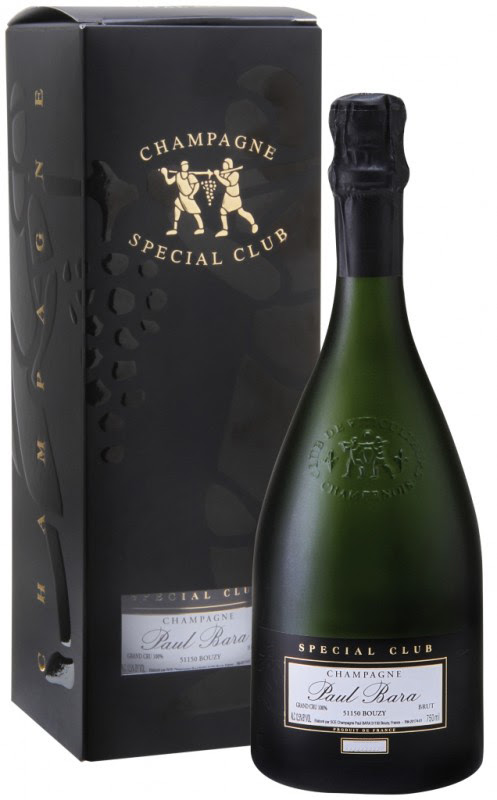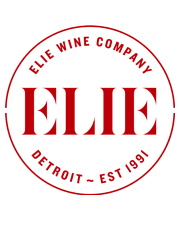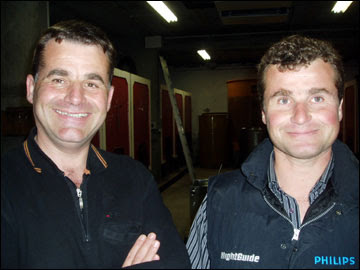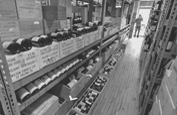The Champagne Society – December 2016 Selection: Champagne Paul Bara
Champagne Paul Bara Spécial Club Brut Grand Cru Millésimé 2005
“The Champagnes of Paul Bara and his daughter Chantale are essential references for anyone who wants to enjoy and understand the ripe, dry richness of Bouzy…” – Andrew Jefford, author of The New France
 Our Champagne Society selections are remarkable for many reasons but we wanted to offer something truly special for the holidays.
Our Champagne Society selections are remarkable for many reasons but we wanted to offer something truly special for the holidays.
The Club Trésors de Champagne or “Spécial Club of Champagne” comprises 28 grower/producers from the finest areas of the Champagne region, each one recognized for the quality of their work. For a Champagne to be recognized as Spécial Club it may only be made in outstanding vintage years and is also subject to two blind tastings by a selected panel of experts, once at the still wine stage before bottling and again after three years aging in bottle. Only then can the Champagne be offered in the unique bottle which may not be used by anyone except the members of the Club Trésors.
This is the grower Champagne version of the famous Champagne house’s Têtes de Cuvée (their best, most prestigious cuvées) and usually at a fraction of the price.
 Author of the book “History of Bouzy,” Paul Bara is a legend of this Cru within the Montagne de Reims zone known for some of the best Pinot Noir in all of Champagne. The key to Bouzy’s inherent greatness lies in its deep, chalky subsoil which imparts intense expression of fruit and great mineral complexity in its Grand Cru wines. Today it is Paul’s eldest daughter Chantale, the seventh generation of winemakers in the family, that manages their 26 acre estate (all within the Grand Cru of Bouzy) maintaining the tradition of utmost quality and terroir-driven wines.
Author of the book “History of Bouzy,” Paul Bara is a legend of this Cru within the Montagne de Reims zone known for some of the best Pinot Noir in all of Champagne. The key to Bouzy’s inherent greatness lies in its deep, chalky subsoil which imparts intense expression of fruit and great mineral complexity in its Grand Cru wines. Today it is Paul’s eldest daughter Chantale, the seventh generation of winemakers in the family, that manages their 26 acre estate (all within the Grand Cru of Bouzy) maintaining the tradition of utmost quality and terroir-driven wines.
Paul Bara Spécial Club Brut Grand Cru Millésimé 2005 is comprised of 70% Pinot Noir and 30% Chardonnay from vines near 40-years-old. With a minimum of five years of aging before disgorgement this wine has developed a profound blend of richness and energy. It is seamless, and somehow simultaneously delicate and powerful with assertive notes of citrus, spice and buttered toast.
- - -
Posted on 2016.11.28 in France, The Champagne Society, Champagne | Read more...
Jurassic and Savoie Tasting — Ideal for the Thanksgiving Table
This Saturday, 12-4, we’ll be tasting a selection of wines from several producers in the ancient Jura and Savoie region of France.
Importer Charles Neal will be on hand to discuss the wines in detail. Based in San Francisco, Charles is a leading authority on wine from the east and Southwest of France as well as brandy, having written books on both Armagnac and Calvados. Charles’ philosophy is simple: find high quality wines from small growers that display the grape variety from which they come and the terroir upon which they are grown.
The Jura is a bucolic region near the eastern border of France. It is the first steps to the Alps and named after the Jurassic period and the warm seas that left their geologic mark there as limestone. Lying just across the Saône Valley from Burgundy, one finds many of the vines planted to be Chardonnay and Pinot Noir, along with indigenous varieties like Savignin, Poulsard and Trousseau.
Savoie is even further east than Jura and higher into the French Alps. The vertical dimension is most important, as a well directed slope and mountain buffers are key to proper ripening. Geologically complex, viticulture there is pure opportunism, and only two percent of the region’s agricultural lands are occupied with vines. Our tasting will be focused mainly on deeply colored, highly aromatic wines from the Mondeuse variety.
If you want a glimpse of what good wine tasted like in the time of Shakespeare, look to these Alpine producers that have mostly eschewed the fashions of wine industry and have excelled at crafting the classic wines of the region. These are all excellent wines to pair with dishes on the Thanksgiving table.
Featured Producers
Maison Angelot is run by the brothers Eric and Philippe Angelot. Their 57 acres of vineyards are divided into about 20 different parcels on the hillsides of Bugey. Maison Angelot Mondeuse is a fruit forward, easy drinking red wine to pair with cheese courses or turkey and stuffing.
The Grand family has been in the Pupillin region for over 300 years. Seventh generation vigneron Lothain Grand studied winemaking in Beaune and did internships in Meursault and the Jura. His son, Emmanuel is now taking charge of the estate. Domaine Grand Pinot Noir comes from 20 to 40 year-old vines grown on a clay and limestone slope.
Domaine Edmund Jacquin is run by brothers Patrice and Jean-Francois Jacquin and is spread over 55 acres exposed south and southwest — ideal for trapping the light and warmth of the sun in this cool climate. Jacquin’s expression of the Mondeuse variety is pure red cherry fruits, floral and earthy notes.
Rising star Yann Agostini’s wine studies have taken him to St. Émilion, Cahors, Yarra Valley, Châteauneuf du Pape, and finally back home to the Hautes Alpes where he manages a little over 11 acres of vines. La Mémoire Neuve is made with 100% Mollard from vines ranging in age from 5 to 55 years old. Soft on the palate with black fruit and a savory note of black pepper, it’s quite versatile at the table.
 Domaine Jean-Pierre et Jean-François Quénard
Domaine Jean-Pierre et Jean-François Quénard
You can find up to a half dozen domaines named Quenard just on a single signpost along the route du vin southeast of Chambéry but only one of them is the impressive Jean-François Quénard. He owns 37 acres of vineyards around the village of Chignin and took over winemaking from his father after studying in Burgundy, Gigondas, Bordeaux, and California. His cuvée “Elisa” is classic Mondeuse.
Young Fabien Trosset recently took over management of the family’s 39 acre estate in the Combe de Savoie Cru of Arbin. He works mainly with the Mondeuse variety grown on severe, south-facing slopes. His wines, particularly the age-worthy cuvée “Avalanche” made from 50+ year-old vines, are fleshy and pungent reds with a hint of mountain herbs.
 Domaine Rondeau
Domaine Rondeau
In the tiny hamlet of Boyeux-Saint-Jérôme husband-and-wife team Marjorie and Bernard Rondeau produce only one wine, the sparkling rosé Cerdon de Bugey. After meeting at University in Bordeaux while they were both studying wine, the couple moved back to Marjorie’s home to take over her family’s vineyards. Their Cerdon de Bugey is made from 100% Gamay and is always on point. This is a perfect aperitif with just the right amount of juicy acidity to balance a light sweetness.
Domaine Labet is a name to follow in the Jura. The family’s 29 acres of vineyards are in the small town of Rotalier in eastern France. Winemaker Julien Labet studied at Domaine Ramonet in Chassagne-Montrachet among others, and since taking over winemaking responsibilities has added production of non-oxidative, ouillé wines in search of the expression of Jura terroir. These bracing, crystalline wines are benchmarks in the region.
- - -
Posted on 2016.11.16 in France, Saturday Sips Wines, French Rarities | Read more...
2012 Château Carbonnieux – A Red Bordeaux for the Table and the Cellar
Château Carbonnieux (Pessac-Léognan, 2012) Red
Special Price: $264/6-pack ($44/bottle)
 One of the highlights of our Bordeaux MasterClass earlier this year was Eric Perrin’s Château Carbonnieux red and white wines from the Pessac-Léognan region of Bordeaux. Since these were such exquisite wines we decided to stock up for autumn and we’re happy to report that these wines are drinking even better than they were earlier this year.
One of the highlights of our Bordeaux MasterClass earlier this year was Eric Perrin’s Château Carbonnieux red and white wines from the Pessac-Léognan region of Bordeaux. Since these were such exquisite wines we decided to stock up for autumn and we’re happy to report that these wines are drinking even better than they were earlier this year.
Château Carbonnieux red is a blend of 60% Cabernet Sauvignon, 35% Merlot, and 5% Petit Verdot that spent 16-18 months in barrels (35% new oak). A heady and complex nose of black currant, cherry, mocha and cedar precedes a rich and full-bodied sip of generous, concentrated fruit. The copious but integrated structure provides excellent balance on the finish and the promise of further development in a proper cellar over the next 15 years.
One of the oldest estates in the entire Bordeaux wine region with a history dating back to the 12th century, Château Carbonnieux has 220 acres of vineyards in the gravel, sand and clay soils of Pessac-Léognan. They are one of the few Bordeaux estates to produce close to equal amounts of red and white Bordeaux wine, with base grapes of Cabernet Sauvignon and Sauvignon Blanc, and both equally stunning.
The history of the modern Château Carbonnieux dates from the 1950s, when Marc Perrin (Grandfather to Eric) acquired the estate. A fresh start was made after the harsh winter of 1956 wiped out the remaining vines in what were by that time rather unkempt vineyards. But this is prime real estate, as illustrated by Château Carbonnieux’s neighbors Château Smith Haut Lafitte and Château Haut-Bailly. The estate has recently added new, temperature controlled, stainless steel vats to allow vinification on a parcel by parcel basis. Today, Château Carbonnieux is considered one of the top estates in Bordeaux.
If you’re doing your holiday shopping early, both the white and red wines of Château Carbonnieux come in attractive wood 6-pack boxes. These boxes filled with delicious, cellar-worthy wine would make a fantastic gift for the wine lover in your life (even if that wine lover is you).
Also available at the same price is the elegant and refined 2014 Château Carbonnieux white. It’s a blend of 75% Sauvignon, 25% Semillon that was barrel-fermented in 25% new French oak and then aged another 10 months in the barrel. Scents of apple blossom and lemon curd precede a crisp and elegant palate with a focused, stony finish. Break out a few bottles this holiday season to pair with dishes like lobster ravioli or pan-fried scallops with beurre blanc and throw a handful in the cellar for future drinking.
- - -
Posted on 2016.11.09 in France, Bordeaux, Saturday Sips Wines | Read more...
The Quenching Beauty of Domaine Chignard Cru Beaujolais
Domaine Chignard “Les Moriers” (Fleurie 2015) Red
Special Price: $132/6-pack ($22/bottle)
The beauty of quality Cru Beaujolais has always resided somewhere in the first few sips from a freshly poured glass, when with rosy cheeks and twinkling eyes one recognizes the pure joyous energy of well made wine from this historic region. It’s laughter and revelry in a bottle.
With a wonderful floral bouquet befitting it’s appellation name of Fleurie, 2015 Domaine Chignard “Les Moriers” is nearly everything you want in a bottle of Cru Beaujolais. Medium-bodied with fleshy ripe red fruit and a harmonious structure it is somehow simultaneously uncomplicated and consequential.
 Fourth-generation vigneron Michel Chignard has always made benchmark Fleurie wines from his 19 acre parcel of naturally low-yielding 60+ year-old Gamay vines in the lieu-dit of Les Moriers, a steep vineyard that penetrates into the Moulin-à-Vent zone. It is said this vineyard can produce wines that are like a marriage of the two – the floral and feminine aspects of Fleurie, coupled with the depth and pungency of Moulin-à-Vent.
Fourth-generation vigneron Michel Chignard has always made benchmark Fleurie wines from his 19 acre parcel of naturally low-yielding 60+ year-old Gamay vines in the lieu-dit of Les Moriers, a steep vineyard that penetrates into the Moulin-à-Vent zone. It is said this vineyard can produce wines that are like a marriage of the two – the floral and feminine aspects of Fleurie, coupled with the depth and pungency of Moulin-à-Vent.
Today, it is Michel’s son Cédric Chignard that manages the domaine, carrying on his father’s philosophy of passionate perfectionism. Indeed, with a mere 3,000 cases of annual production, it is a matter of focus on traditional vineyard management and winemaking. Take good care of these old-vine root systems that run very deep, accessing minerals from the granite subsoil, and be rewarded with a wine of terroir and great freshness.
All grapes are harvested by hand. In the cellar, vinification is natural, in keeping with the local tradition, including whole cluster fermentation that takes place in stainless steel and cement cuves. The wine is aged in old foudres for 13 months before being bottle unfined and unfiltered. This is an ideal wine to stock up and drink through the holidays and into next year.
And if you’re looking for party-sized bottles, we have a limited amounted of Chignard “Les Moriers” in 1.5 liter magnums.
- - -
Posted on 2016.11.02 in France, Saturday Sips Wines, Beaujolais | Read more...
Thrilling Barbera from A Rising Star in Piedmont Italy
Vigne Marina Coppi “Sant’ Andrea” (Colli Tortonesi Barbera 2012) Red
$24/bottle
 It was a little over a decade ago that Francesco Bellocchio of Vigne Marina Coppipurchased an 11 acre vineyard in the small village of Castellania. The tiny plot once belonged to his grandfather, Fausto Coppi, a legendary cyclist who died before Francesco was born. With such small vineyards, Francesco and his wife, Anna, are able to have total control of the land and the winemaking process. They do it all themselves, producing a mere 2,000 cases per year of top-class Colli Tortonesi wine using organic and biodynamic techniques. Everything is harvested by hand on their hillside vineyards at around 1,300 feet of elevation. The vines benefit from clay, sand and limestone soils and the cool nights and sunny days of Piedmont.
It was a little over a decade ago that Francesco Bellocchio of Vigne Marina Coppipurchased an 11 acre vineyard in the small village of Castellania. The tiny plot once belonged to his grandfather, Fausto Coppi, a legendary cyclist who died before Francesco was born. With such small vineyards, Francesco and his wife, Anna, are able to have total control of the land and the winemaking process. They do it all themselves, producing a mere 2,000 cases per year of top-class Colli Tortonesi wine using organic and biodynamic techniques. Everything is harvested by hand on their hillside vineyards at around 1,300 feet of elevation. The vines benefit from clay, sand and limestone soils and the cool nights and sunny days of Piedmont.
A Vigne Marina Coppi Masterpiece, cuvée “Sant’ Andrea” is a blend of 90% Barbera and 10% Croatina from a single 2.5 acre plot. Grapes are picked at peak maturity and the wine is fermented and aged entirely in stainless steel. This is about as pure and juicy as Barbera gets. Like a bucket of summer berries in a sun-drenched meadow. It’s a wine that makes you want to throw a party if only to drink it with friends. 558 total cases produced.
With its many overlapping appellations spread across the largest region of the Italian mainland, it takes a bit of work to wrap one’s brain around the wines of Piedmont. But what makes Piedmont so complicated also makes it exciting. While most wine drinkers have heard of Barolo and Barberesco there are another three dozen Piedmont wine zones that rarely see foreign markets. Colli Tortonesi is one of them.
Colli Tortonesi lies in the easternmost part of Piedmont on the hills surrounding the town of Tortona in the province of Alessandria, extending from Monferrato to Oltrepò Pavese. Production has been dominated by fizzy white wine made from Cortese grapes but more recently passionate winemakers like Francesco are driving both consumers and media to recognize the potential of Colli Tortonesi to produce wines of distinction.
- - -
Posted on 2016.10.26 in Saturday Sips Wines, Piedmont, Italy | Read more...
Featured Wines
- Notebook: A’Boudt Town
- Saturday Sips Wines
- Saturday Sips Review Club
- The Champagne Society
- Wine-Aid Packages
Wine Regions
Grape Varieties
Albarino, Albarín Blanco, Albarín Tinto, Albillo, Aleatico, Aligote, Arbanne, Aubun, Barbarossa, barbera, Biancu Gentile, bourboulenc, Cabernet Franc, Caino, Calvi, Carcajolu-Neru, Carignan, Chardonnay, Chasselas, Cinsault, Clairette, Cortese, Corvina, Counoise, Dolcetto, Erbamat, Ferrol, Friulano, Fromenteau, Gamay, Garnacha, Garnacha Tintorera, Gewurztraminer, Graciano, Grenache Blanc, Groppello, Juan Garcia, Lambrusco, Loureira, Macabeo, Macabou, Maconnais, Malbec, manseng, Marcelan, Marsanne, Marselan, Marzemino, Mondeuse, Montanaccia, Montònega, Morescola, Morescono, Moscatell, Mourv, Mourvèdre, Muscat, Natural, Nebbiolo, Niellucciu, Parellada, Patrimonio, Pedro Ximénez, Persan, Petit Meslier, Petit Verdot, Pineau d'Aunis, Pinot Blanc, Pinot Gris, Pinot Meunier, Pinot Noir, Pouilly Fuisse, Pouilly Loche, Prieto Picudo, Riesling, Rondinella, Rousanne, Roussanne, Sagrantino, Sauvignon, Sauvignon Blanc, Savignin, Sciacarellu, Semillon, Serine, Sparkling, Sumoll, Sylvaner, Syrah, Tannat, Tempranillo, Teroldego, Timorasso, Trebbiano, Trebbiano Valtenesi, Ugni Blanc, vaccarèse, Verdicchio, Vermentino, Xarel-loWines & Events by Date
- September 2025
- August 2025
- July 2025
- June 2025
- May 2025
- April 2025
- March 2025
- February 2025
- January 2025
- December 2024
- November 2024
- October 2024
- September 2024
- August 2024
- July 2024
- June 2024
- May 2024
- April 2024
- March 2024
- February 2024
- January 2024
- December 2023
- November 2023
- October 2023
- September 2023
- August 2023
- July 2023
- June 2023
- May 2023
- April 2023
- March 2023
- February 2023
- January 2023
- December 2022
- November 2022
- October 2022
- September 2022
- August 2022
- July 2022
- June 2022
- May 2022
- April 2022
- March 2022
- February 2022
- January 2022
- December 2021
- November 2021
- October 2021
- September 2021
- August 2021
- July 2021
- June 2021
- May 2021
- April 2021
- March 2021
- February 2021
- January 2021
- December 2020
- November 2020
- October 2020
- September 2020
- August 2020
- July 2020
- June 2020
- May 2020
- April 2020
- March 2020
- February 2020
- January 2020
- December 2019
- November 2019
- October 2019
- September 2019
- August 2019
- July 2019
- June 2019
- May 2019
- April 2019
- March 2019
- February 2019
- January 2019
- December 2018
- November 2018
- October 2018
- September 2018
- August 2018
- July 2018
- June 2018
- May 2018
- April 2018
- March 2018
- February 2018
- January 2018
- December 2017
- November 2017
- October 2017
- September 2017
- August 2017
- July 2017
- June 2017
- May 2017
- April 2017
- March 2017
- February 2017
- January 2017
- December 2016
- November 2016
- October 2016
- September 2016
- August 2016
- July 2016
- June 2016
- May 2016
- April 2016
- March 2016
- February 2016
- January 2016
- December 2015
- November 2015
- October 2015
- September 2015
- August 2015
- July 2015
- June 2015
- May 2015
- April 2015
- March 2015
- February 2015
- January 2015
- December 2014
- November 2014
- October 2014
- September 2014
- August 2014
- July 2014
- June 2014
- April 2014
- March 2014
- February 2014
- January 2014
- December 2013
- November 2013
- October 2013
- September 2013
- August 2013
- July 2013
- June 2013
- May 2013
- April 2013
- March 2013
- February 2013
- January 2013
- December 2012
- November 2012
- October 2012









